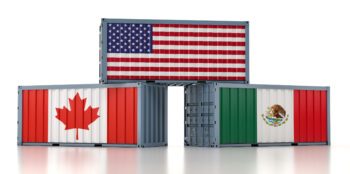By Paul Fudacz, Senior Attorney, Braumiller Law Group
Most trade professionals are quite familiar with the long-standing country of origin marking rules applicable to foreign produced goods imported and sold into the U.S., but many are not quite so familiar with the country of origin rules applicable to goods traded between the three NAFTA countries.
The U.S. marking statute, (Section 304, Tariff Act of 1930), requires that unless excepted, every article of foreign origin, or its container, imported into the U.S. shall be marked with its country of origin. Goods that are imported into the U. S. are required to have a country of origin marking, such as; the country of manufacture, production, or growth of any article of foreign origin entering the United States.
When goods are the product of more than one country, or when the imported goods are subject to further processing in the U.S., the marking rules require that a “substantial transformation” test be applied, whereby the country of origin for marking purposes is the country in which the good underwent a substantial transformation; meaning, it was further produced into an article having a new name, use, or character.
However, different sets of marking rules apply for goods traded between the three NAFTA countries. Under the NAFTA, Canada, Mexico and U.S. were permitted to institute their own country of origin marking rules applicable to goods imported from the other two trade agreement partners. This article however, focuses only on the U.S rules developed pursuant to the NAFTA, and therefore addresses the physical marking requirements applicable to goods imported into the U.S. from Canada or Mexico.
At the outset it is important to distinguish the NAFTA country of origin marking rules from the NAFTA Rules of Origin. The NAFTA rules of origin are applied to determine if goods traded between the NAFTA countries qualify for tariff preference purposes. If a good does not satisfy the NAFTA rules of origin, that is the end of the analysis for tariff preference purposes. However, for marking purposes, for goods arriving from Canada or Mexico, a specific determination must be made under the NAFTA marking rules, even if the good does not qualify as originating for tariff purposes. Also, the same NAFTA marking rules are used to determine the Country of Origin of goods imported into the U.S. from the other NAFTA countries.
The NAFTA marking rules are set forth under 19 CFR Part 102. There are certain similarities between the NAFTA marking rules and the NAFTA rules of origin including similar terminology, as well as the use of tariff shift rules which apply in most marking determinations. The three basic rules under Part 102 involve the marking of goods; 1) wholly obtained or produced in a country, 2) produced exclusively of domestic materials, or 3) otherwise meeting a specific tariff shift rule.
‘Wholly obtained or produced” is defined under Part 102 and includes such items as minerals extracted in a single country, vegetables harvested in a given country, live animals, as well as other goods obtained from the sea, or otherwise comprising content solely obtained from within the territory of a single country.
A “Domestic Material’ is defined under Part 102 and means a material whose country of origin as determined under the Part 102 rules is the same country as the country in which the good is produced. In other words, if a material is determined to be the same country of origin as the finished good after applying the Part 102 marking rules to the material alone, the material is a Domestic Material.
For products not meeting the first two origin rules, the third rule involves application of specific tariff shift rules. Similar to the rules of origin, under the tariff shift rule each material of foreign origin incorporated into the good must undergo an applicable change in tariff classification in a given country.
If the country of origin cannot be determined by application of the three primary methods above, an alternative method must be used, which in most cases involves the identification of the single material that imparts the ‘essential character” to the good.
Other rules under Part 102 apply only to textile and apparel products classified in HTS chapter 50 through 63, and generally incorporate either “wholly obtained or produced” criteria or tariff shift criteria, and similar to the first three general rules if the country of origin cannot be determined on this basis, an alternate method must be used based on factors such as where the good was knit, or alternatively, where the good was wholly or partially assembled.
In conclusion, this overview is not intended to be a comprehensive practitioner’s guide for determining the country of origin for marking purposes under the NAFTA, but hopefully will be instructive to reinforce the understanding that separate and distinct marking rules apply for goods imported into the U.S. from Canada and Mexico, and will also provide a starting point for a practitioner to undertake a NAFTA marking analysis in conjunction with careful reference to the Part 102 regulations.

























